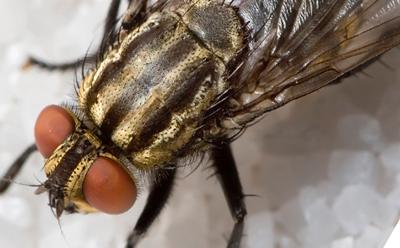Electric fields signal ‘no flies zone’

A new piece of research led by the University of Southampton has found that the behaviour of fruit flies, which are commonly used in laboratory experiments, is altered by electric fields.
The research indicates that the wings of the insects are disturbed by static electric fields, leading to changes in avoidance behaviour and the neurochemical balance of their brains.
The paper, published in the Proceeding of the Royal Society B, suggests that the plastic housing laboratory fruit flies are commonly kept in (which hold their own static electric charge) could agitate the flies, changing their behaviour and neurochemical profile which has the potential to impact or confound other studies for which they are being used.
“Fruit flies are often used as model organisms to understand fundamental problems in biology,” say Professor Philip Newland, Professor of Neuroscience at the University of Southampton and lead author of the study. “75 per cent of the genes that cause disease in humans are shared by fruit flies, so by studying them we can learn a lot about basic mechanisms.
“Plastic can retain a charge for a long period and, given the use of plastic in the rearing of these insects and other small insects such as mosquitos, long term exposure to these fields is inevitable.”

The researchers put fruit flies in a Y-shaped maze, with one arm of the maze exposed to an electric charge and the other receiving none. They found that the flies avoided the charged chamber and gathered in the non-charged arm. Interestingly flies with no wings didn’t display this behaviour, and flies with smaller wings only avoided higher charges - suggesting it is the wings of the fly that are involved in detection and are affected by the fields.
This was borne out when subjecting stationary flies to electric fields. The researchers observed that the wings of the flies could be manipulated by a field of a similar strength to that which produced the avoidance behaviour.
Professor Newland explains: “When a fly was placed underneath a negatively charged electrode, the static field forces caused elevation of the wings toward the electrode, as opposite charges were attracted.
“Static electric fields are all around us but for a small insect like a fruit fly it appears these fields’ electrical charges are significant enough to have an effect on their wing movement and this means they will avoid them if possible.”

The effect on the wings being moved seems to agitate the flies, as revealed by changes in their brain chemistry. Flies exposed to an electric field showed increased levels of octopamine (similar to noradrenaline in humans) which indicates stress and aggression. The flies also showed decreased levels of dopamine, meaning they would be more responsive to external stimuli.
As well as having consequences for flies used in laboratories, the results also have implications for flies in their natural environment.
“We are particularly interested in how electric fields could be used in pest control,” says co-author Dr Christopher Jackson, also of Southampton. “Meshes that can generate static electric fields could be put across windows of houses or green houses to prevent insects like fruit flies or even mosquitos entering, yet allow air movement.”
“It also raises questions of how pollinating species like bees could be affected by power lines, which have stronger electric fields.”

